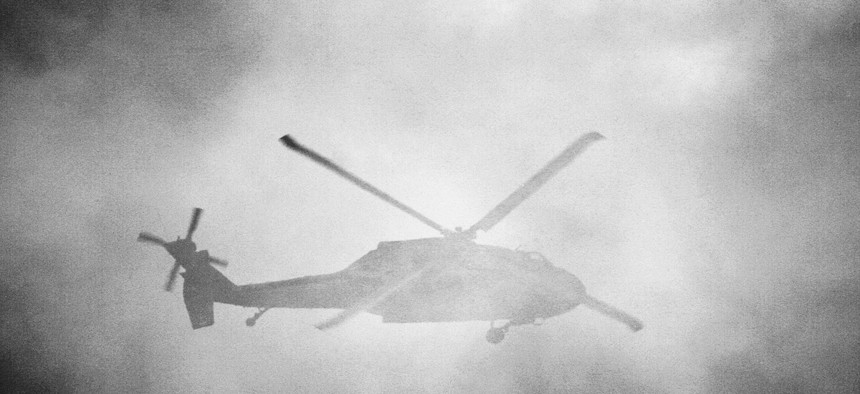
A United States Army Sikorsky UH-60 Blackhawk flies behind a cloud of smoke during the Combined Arms Demonstration at the Rhode Island National Guard Open House and Airshow, held at Quonset State Airport (KOQU/OQU) in North Kingstown, RI. Flickr image via Matt Hintsa
Black Hawk Empty: Unmanned Helicopter Passes Key Test
The Army’s signature rotorcraft, equipped with new hardware and software, shows off a new self-piloting capability and robotic teaming.
A self-flying Black Hawk helicopter delivered a small robotic amphibious all-terrain vehicle, or AATV, to a Florida drop zone on Tuesday, passing a critical test in autonomous helicopter flight and robot teaming, an Army official said.
The helicopter, flying autonomously — it also can be piloted remotely — “came in, picked up [the AATV], flew five to seven kilometers in an air route, delivered it to a ground location and released it. The unmanned ground vehicle moved through a ten-kilometer scenario where it faced different chemical, biological hazards and then fed that data back via satellite,” said Paul Rogers, who directs Army’s Tank Automotive Research Development and Engineering Center, or TARDEC.
The test took place at Sikorsky’s Aircraft Development Flight Center near West Palm Beach, Florida, Rogers said at at the Unmanned Systems Defense conference in Pentagon City today.
Last year, Sikorsky announced plans to build an unmanned version of their UH-60A, more commonly called the Black Hawk, and began remotely piloted test flights. The company's hardware-and-software kit called Matrix has since advanced to allow far greater self-steering. The company does much of its development work aboard its Sikorsky Autonomy Research Aircraft, or SARA.
The recent experiment marks the most important demonstration of the technology yet, including the collaboration with the robotic AATV, which was developed in part by researchers at Carnegie Mellon.
“Sikorsky has really advanced their technology quite a bit on the unmanned side with their own internal research and development,” TARDEC roboticist Robert Sadowski told Defense One.
Sadowski noted that the Army has some 2,500 Black Hawks. “If you can retrofit them,” he said, “now you can do autonomous logistics when the crew is resting. It gives you the ability to have an enhanced operational tempo. It can be retrofitted across the older UH-60s. In fact, they’re trying to do that to show that it can be done.”
It also shows that Sikorsky, and merger partner Lockheed Martin, are emerging as leaders in autonomous helicopter flight with no close second. Last spring, Lockheed, with helicopter maker Kaman, demonstrated that their K-MAX robot helicopter could fight fires as well as resupply troops.
NEXT STORY: Now We Have a (Tiny) Tractor Beam



